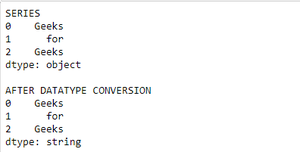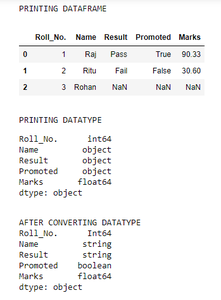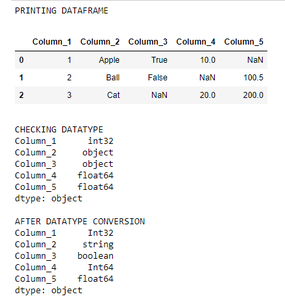How to Convert to Best Data Types Automatically in Pandas?
Last Updated :
02 Dec, 2020
Prerequisite: Pandas
In pandas datatype by default are int, float and objects. When we load or create any series or dataframe in pandas, pandas by default assigns the necessary datatype to columns and series.
We will use pandas convert_dtypes() function to convert the default assigned data-types to the best datatype automatically. There is one big benefit of using convert_dtypes()- it supports new type for missing values pd.NA along with NaN. It is supported in pandas 1.1.4 version.
Syntax:
For Series:
series_name.convert_dtypes()
For DataFrame:
dataframe_name.convert_dtypes().dtypes
The following is the implementation for both series and data frame:
Converting the datatype of a series:
- Import module
- Create a series
- Now use convert_dtypes() function to automatically convert datatype
Example:
Python3
import pandas as pd
s = pd.Series(['Geeks', 'for', 'Geeks'])
print("SERIES")
print(s)
print()
print("AFTER DATATYPE CONVERSION")
print(s.convert_dtypes())
|
Output:

Converting the datatype of a dataframe:
- Import module
- Create data frame
- Check data type
- Convert data type using convert_dtypes().dtypes function
The data type of columns are changed accordingly. But the datatype of dataframe will remain object because it contains multiple columns with each column has a different datatype.
Example:
Python3
import pandas as pd
import numpy as np
df = pd.DataFrame({"Roll_No.": ([1, 2, 3]),
"Name": ["Raj", "Ritu", "Rohan"],
"Result": ["Pass", "Fail", np.nan],
"Promoted": [True, False, np.nan],
"Marks": [90.33, 30.6, np.nan]})
print("PRINTING DATAFRAME")
display(df)
print()
print("PRINTING DATATYPE")
print(df.dtypes)
print()
print("AFTER CONVERTING DATATYPE")
print(df.convert_dtypes().dtypes)
|
Output:

Creating the Data frame through series and specifying datatype :
- Import module
- Create dataframe through series and specify datatype along with it
- Check data type
- Convert using convert_dtypes().dtypes function
Example:
Python3
import pandas as pd
import numpy as np
df = pd.DataFrame({"Column_1": pd.Series([1, 2, 3], dtype=np.dtype("int32")),
"Column_2": pd.Series(["Apple", "Ball", "Cat"],
dtype=np.dtype("object")),
"Column_3": pd.Series([True, False, np.nan],
dtype=np.dtype("object")),
"Column_4": pd.Series([10, np.nan, 20],
dtype=np.dtype("float")),
"Column_5": pd.Series([np.nan, 100.5, 200],
dtype=np.dtype("float"))})
print("PRINTING DATAFRAME")
display(df)
print()
print("CHECKING DATATYPE")
print(df.dtypes)
print()
print("AFTER DATATYPE CONVERSION")
print(df.convert_dtypes().dtypes)
|
Output:

Share your thoughts in the comments
Please Login to comment...